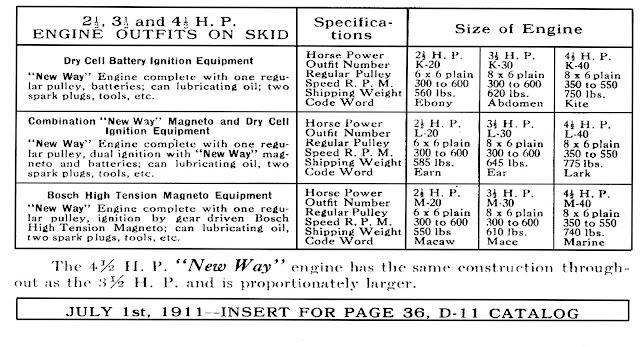New - Way's wonderfull "GOES AND GOES RIGHT" advertising slogan no doubt sold many an engine and probably well deserved to say the least. That said, it is not all plain sailing for the uninitiated.
New - Way Owners Pitfalls !!!
- Don't set the Oil drip feed too fast - eventually the crank case will over fill and your New Way aircooled engine will likely start spewing oil everywhere.
- Rich Mixture / Too much oil in cylinder- Carbon deposits in the combustion chamber may occur that glow and result in preignition. Indicated if motor continues running when you've shut the ignition down. May be treated temporarily with kerosene to remove deposits but you need to identify cause and permanently correct.
- Weak batteries with Buzz ignition - Motor will likely start. Symptoms -slowly loose power (or stop) and likely misfire from weak spark. Always disconnect batteries to prolong battery life - even overnight.
- Flick the drip feeder off when motor shut down - Failure will also eventually overfill the crankcase etc.
- Fan oil line check valve sticks - Cylinder mounted fans have an in line valve that can stick closed. Tap valve to free it up ensuring oil mist is feeding the fan shaft. Remove gummy oil deposits from valve and oil line if necessary. NOTE:- Oiling mist in line to fan is reliant on adequate crank case pressure.
- Don't push the piston in too far - Rings may catch on a rebate at the top of the cylinder when restoring and assembling . It's best to connect the rod to the crank early to stop the nightmare this action may give.
- Oil Mud on Cylinder Fins and Overheating - Don't let your New - Way's propensity to be an oily machine to build a thick coating of oil mud on the cylinder cooling fins. It has the potential to insulate the cylinder from air cooling and overheat your motor which can be disasterous for ring tensions and bore.
- Don't forget to always tighten the Sparkplug - Some New - Way's have high intake lift and you may be inclined to give it a snort of fuel to start it more readily. Forget to tighten and you may find you have launched a very powerful and dangerous missile after an extended period of running. Be assured it has happened - be careful.
- Joint sealing is critical on high lift air intakes -New - Way uses press fit sealing on their intake pipe at mixer and cylinder on some models. With high lift intakes, a good seal is essential for correct mix and power - ensure air isn't being sucked in. (put fluid on the joints to detect leaks with motor running)
- 4 Gear Drive Ignition and Exhaust Valve Timing - Don't fiddle unless you know what you are doing New - Way even suggests you don't disturb. If you must, ensure you mark gears (pin punch) and restore.
- Don't know what you are doing? - Welcome to the club, you aren't the first - You've had a go - call on another enthusiast they are usually only too happy to help you out, in fact they have probably been there before. (Though they mightn't admit it!)




